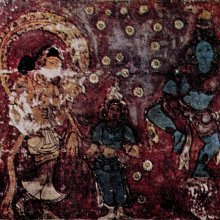Sundarar: 1 definition
Introduction:
Sundarar means something in Hinduism, Sanskrit. If you want to know the exact meaning, history, etymology or English translation of this term then check out the descriptions on this page. Add your comment or reference to a book if you want to contribute to this summary article.
Images (photo gallery)
In Hinduism
Vastushastra (architecture)
Source: Shodhganga: Temples of Salem region Up to 1336 ADSundarar.—One of the four Nālvar.—Sundarar is usually represented as a sage with matted locks.

Vastushastra (वास्तुशास्त्र, vāstuśāstra) refers to the ancient Indian science (shastra) of architecture (vastu), dealing with topics such architecture, sculpture, town-building, fort building and various other constructions. Vastu also deals with the philosophy of the architectural relation with the cosmic universe.
See also (Relevant definitions)
Starts with: Cuntarar, Sundararaja, Sundararajiya, Sundararanya, Sundararanyamahatmya, Sundararupa.
Ends with: Cuntarar.
Full-text: Anukkanampi, Akaran, Thiruthondathogai, Appar, Venkataraman, Nayaṉmar, Nalvar, Brihadishvara, Avvaiyar, Bhakti, Avvai, Thevaram.
Relevant text
Search found 8 books and stories containing Sundarar; (plurals include: Sundarars). You can also click to the full overview containing English textual excerpts. Below are direct links for the most relevant articles:
Later Chola Temples (by S. R. Balasubrahmanyam)
Appendix 1: Periyapuranam Sculptures in the temple at Darasuram < [Chapter VIII - Temples of Rajaraja II’s Time]
Temples in Tiruvennainallur < [Chapter XII - Temples of Kulottunga III’s Time]
Temples in Achchapuram < [Chapter XII - Temples of Kulottunga III’s Time]
Early Chola Temples (by S. R. Balasubrahmanyam)
Temples in Vriddhachalam < [Chapter VIII - Temples of Uttama Chola’s Time]
Temples in Kuttalam < [Chapter VIII - Temples of Uttama Chola’s Time]
Bronze, group 4: Post-Parantaka I (a.d. 950-985) < [Chapter XI - Sculpture]
Middle Chola Temples (by S. R. Balasubrahmanyam)
Parivaralayattu Pillaiyar < [Tanjavur/Thanjavur (Rajarajesvaram temple)]
Temples in Pachchil Amalisvaram (Gopurapatti) < [Aditya I]
Temples in Tiruppattur (Tiruppidavur) < [Chapter IV - Temples of Rajendra I’s Time]
Temples in and around Madurantakam (by B. Mekala)
Appendix 3: Thiru Aatcheeswarar Temple Layout
Atcheeswarar Temple at Acharapakkam < [Chapter 4 - Prominent Temples in Madurantakam Taluk]
Sri Venkateswarar Temple < [Chapter 4 - Prominent Temples in Madurantakam Taluk]
The Religion and Philosophy of Tevaram (Thevaram) (by M. A. Dorai Rangaswamy)
Nayanar 1: Sundarar (Nampi Arurar) < [Volume 4.1.1 - A comparative study of the Shaivite saints the Thiruthondathogai]
Love of God in Saivism < [April – June, 1980]
Administration of Justice in Tamil < [January – March 1992]
Reviews < [Jul–Sept 1971]

